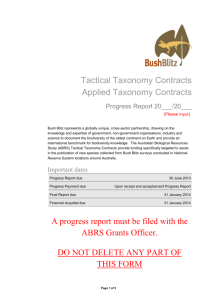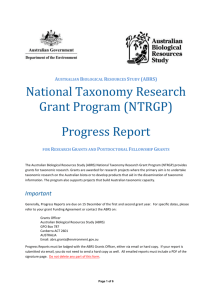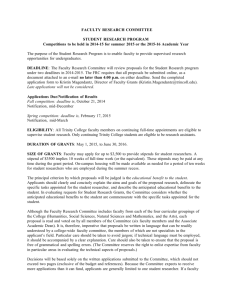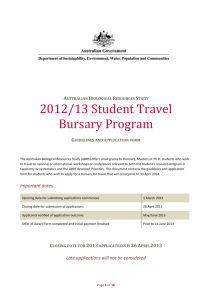Australian Biological Resources StudY honours, masters, Ph.D
advertisement
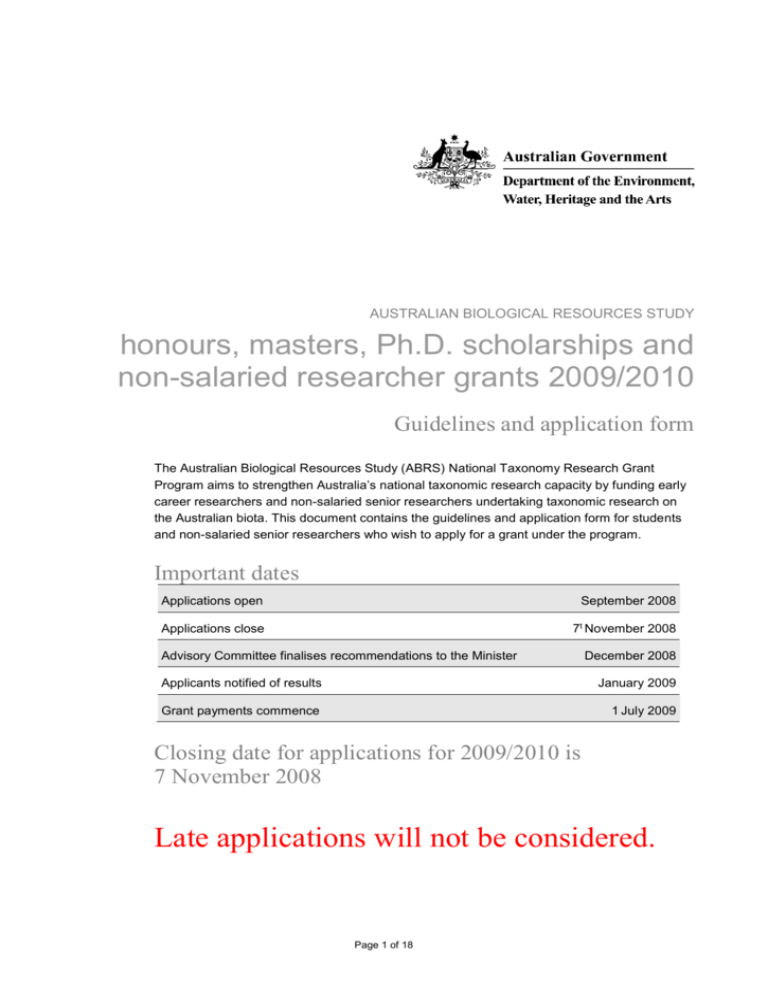
AUSTRALIAN BIOLOGICAL RESOURCES STUDY honours, masters, Ph.D. scholarships and non-salaried researcher grants 2009/2010 Guidelines and application form The Australian Biological Resources Study (ABRS) National Taxonomy Research Grant Program aims to strengthen Australia’s national taxonomic research capacity by funding early career researchers and non-salaried senior researchers undertaking taxonomic research on the Australian biota. This document contains the guidelines and application form for students and non-salaried senior researchers who wish to apply for a grant under the program. Important dates Applications open September 2008 Applications close 7t November 2008 Advisory Committee finalises recommendations to the Minister December 2008 Applicants notified of results January 2009 Grant payments commence 1 July 2009 Closing date for applications for 2009/2010 is 7 November 2008 Late applications will not be considered. Page 1 of 18 Contents Eligibility Criteria .................................................................................................................. 3 Email Conditions .................................................................................................................. 3 Grant types .......................................................................................................................... 4 Question 1: Type of grant requested ........................................................................................................ 5 Question 2: Applicant Details ................................................................................................................... 5 Question 3: Institution and Supervisor Details ......................................................................................... 6 Question 4: Scholarship Applicant Education .......................................................................................... 6 Question 5: Research Experience ............................................................................................................ 7 Question 6: ABRS Research Priorities ..................................................................................................... 8 Question 7: Project details ....................................................................................................................... 9 Question 8: Supervisors .........................................................................................................................11 Question 9: Academic Referees .............................................................................................................12 Important information ......................................................................................................... 13 Certification for Applicant ................................................................................................... 15 Certification for Institution .................................................................................................. 15 Checklist ............................................................................................................................ 16 Attachment A: Priority Areas for Research Grants 2009/2010 ........................................... 17 Page 2 of 18 Read this before you start your application Eligibility criteria 1. Applicants must hold Australian citizenship, or have permanent residency status. 2. The proposed research must be undertaken at an Australian institution. 3. Ph.D. Scholarship applicants must be enrolled as a full-time student. Honours/Masters Scholarship applicants may be enrolled part-time. 4. Applicants must not be receiving another equivalent major award, scholarship or salary to undertake the same project. 5. Non-salaried researcher grants are available only to experienced researchers who are not employed professionally as a taxonomist or biologist. This application must be filled in electronically. Non-salaried researcher grant applicants may submit via an email attachment or a mailed CD ROM. Scholarship applicants may submit by a mailed CD ROM only. Emailed applications that do not adhere to the following conditions will not be considered. CD ROM applications must comply with Email Conditions 1 – 2 listed below. Email conditions 1. Applications must be submitted as a single word document or in rich text format (.rtf). 2. All aspects of the application, including the project details and curriculum vitae, must be completed using Arial font in 12 point. 3. The signature page (located on the second to last page of this document) must be received as a secure PDF. 4. Receipt of the application will be acknowledged by an auto reply from ABRS. If this acknowledgment is not received it is your responsibility to contact ABRS to ensure that your application has been received. 5. ABRS accepts no responsibility for emailed applications that arrive with altered formatting. ABRS staff will check the formatting of emailed applications upon receipt and may contact applicants requesting a resubmission if there are any problems. A resubmission must be made within 48 hours of such a request and may require a hard copy delivery or faxed submission. Page 3 of 18 Grant types In the 2009/2010 grants round, there are two sets of capacity-building grants available: general capacitybuilding grants and ABRS/CReefs capacity-building grants. Table 1 below outlines the grants available for general capacity-building. Table 2 outlines the ABRS/CReefs capacity-building grant available for tropical marine researchers. Please note: non-salaried researcher grants are offered on an annual basis to allow the completion of projects by non-salaried researchers. A particular priority for these grants is to capture knowledge from senior, retired professionals and allow mentoring of junior researchers. Table 1: General Capacity-Building Grants 2009/2010 Type of grant & amount (per annum) ABRS contribution (per annum) Duration (years) Honours/Masters (by coursework) Scholarship – $10,000 10,000 1 (or 2 part-time) Ph.D. Scholarship – $30,000 30,000 3 5,000 1 Non-salaried researcher – $5,000 Table 2: ABRS/CReefs Capacity-Building Grants 2009/2010 Type of grant & amount (per annum) Ph.D. Scholarship – $30,000 ABRS contribution (per annum) CReefs contribution (per annum) Duration (years) 15,000 15,000 3 Priority areas for research grants 2009/2010 Projects funded under the National Taxonomy Research Grant Program must be public good in focus and support the Australian Government’s National Research Priorities. The specific criteria used by ABRS to determine whether a project will be eligible for an ABRS grant can be found in Attachment A – Priority Areas for Research Grants 2009/2010. Applicants should familiarise themselves with the priority areas before filling in the application form. Page 4 of 18 Question 1: Type of grant requested Please select the desired grant by placing an x in the grant requested box below. Type of grant & amount (per annum) ABRS contribution (per annum) CReefs contribution (per annum) Grant Requested General Capacity-Building Grants Honours/Masters (by coursework) Scholarship — $10,000 10,000 n/a Ph.D. Scholarship — $30,000 30,000 n/a 5,000 n/a 15,000 15,000 Non-salaried researcher grant — $5,000 ABRS/CReefs Capacity-Building Grant Ph.D. Scholarship — $30,000 Question 2: Applicant Details Family Name Given Name Address State/Territory Phone Email Residential Status Title of Project Page 5 of 18 Please note: the next section of this document is not applicable to non-salaried researcher grant applicants. Non-salaried researcher grant applicants must instead supply a curriculum vitae (no more than four pages) using Arial 12 point type. Nonsalaried researcher grant applicants should proceed to Question 6. Scholarship applicants must complete the following Questions 3 – 5. Question 3: Institution and Supervisor details Institution (proposed for study) Address of Institution Proposed Supervisor/s Supervisor Phone Supervisor Email Institution Research Office Contact and Phone Number Question 4: Scholarship Applicant Education Scholarship Applicant Tertiary Qualifications & Awards Please list your tertiary qualifications, commencing with the highest level of qualification obtained. Undergraduate/higher degrees Level of Honours (if applying for Masters or Ph.D. Scholarship) Page 6 of 18 Year Completed Institution Please list any academic awards or achievements. Name of Award/Achievement Institution Year Received Please note: scholarship applicants must supply ABRS with a certified hard copy of their most recent academic transcript. Question 5: Research experience Using no more than 200 words, briefly outline any research or employment experience that is related to your proposed project. Page 7 of 18 Question 6: ABRS Research Priorities Please nominate which ABRS Research Priorities are supported by the proposed project by placing an x in the appropriate box/es. Further information regarding these priorities can be found in Attachment A. Priority This Application supports x priority Biodiversity, Conservation and Vulnerable and Endangered Species 1.1 Documenting Australia’s Biodiversity 1.2 Conservation 1.3 Vulnerable and Endangered Species 1.4 Identifying Australia’s Biodiversity Public, Plant and Animal Health 2.1 Public, Plant and Animal Health Building Taxonomic Capacity 3.1 Training of Early Career Researcher/s 3.2 Knowledge Management 3.3 Exchange of International Expertise Using a maximum of 200 words, please explain how the ABRS Research Priorities nominated in the table above will be supported by the proposed project. Page 8 of 18 Question 7: Project details Please describe the proposed project using a maximum of two pages and the subheadings supplied below. Project aim [Please state clearly the primary aims of the project and why the project is necessary.] Method [Please detail the research procedures you intend to use. In the case of fieldwork, give justification of its need, locations to be visited and the estimated time to be spent at each. Please note what is already available in collections and estimate the number of taxa to be described. Also detail the techniques used to determine specimens. If using molecular techniques, please include the number of samples.] Page 9 of 18 Outcomes [Outline the general benefits of the grant. Please specifically cover expected outcomes (for example, to advance scientific knowledge and understanding of a potential bio-indicator for pollution).] Facilities [Please describe the research facilities available for the project.] Page 10 of 18 Question 8: Supervisors Please note: this question is not applicable to non-salaried researcher grant applicants. Non-salaried researcher grant applicants should proceed to Question 9. Please provide details of your nominated supervisor/s, using a maximum of one page and the following subheadings. Please also attach a copy of the Curriculum Vitae of your supervisor/s. Supervisory and research experience Role and responsibilities of supervisors [Please complete only in the case of multiple supervisors.] Page 11 of 18 Question 9: Academic referees Please give the details of two persons who have been asked to support your application. Your referees should be research scientists who are familiar with your most recent work. In the case of students, one referee should be the Head of the Department or School. Title · given name/s · surname Address State/Territory Phone ………/ ……………… Fax ………/ ……………… Email ……………………………………………………… Title · given name/s · surname Address State/Territory Phone ………/ ……………… Fax ………/ ……………… Email ……………………………………………………… Page 12 of 18 Important information You must read this page Freedom of Information All relevant documents are subject to freedom of information (FOI) and are available by making a valid application to the FOI Officer Department of the Environment, Water, Heritage and the Arts GPO Box 787 Canberra ACT 2601 in accordance with the Freedom of Information Act 1982. Protection of information The ABRS Advisory Committee evaluates applications for grants with the assistance of peers in the scientific community both within Australia and overseas. Names of assessors are not released to applicants. Assessors of applications are requested to destroy their copy of the application after completing their assessment. This destruction must be by shredding or pulping, or, in the case of electronic records, rendering the copy unreadable. The ABRS Advisory Committee and ABRS officers are bound to observe confidentiality. Appeals mechanism ABRS has an appeals mechanism for those applicants who believe their proposal has been unfairly treated in terms of the administrative procedures ONLY. Appeals in relation to the content of the proposal, assessor reports or academic judgments made by the Advisory Committee will not be heard. The Advisory Committee will not participate in discussion relating to academic judgments made on grant applications. Applicants wishing to appeal against a decision, based on administrative procedures, may do so by notifying the Director of ABRS in writing. Appeals must be lodged within 28 days from the date on the letter of notification of the outcome of a grant application. An appeals panel of three people will be convened to consider appeals. If the appeals panel finds evidence that the original decision was the result of undue administrative process, it will direct the application be reappraised. Permits All collecting activities carried out as part of research funded or otherwise supported by ABRS must be undertaken in full compliance with the laws and regulations of the States and Territories of the Commonwealth of Australia. There are substantial fines for illegal collecting in most States, and these are enforced. A range of authorities in each of the States and Territories is responsible for the issue of permits for biological collection. Relevant information may be obtained from the leading wildlife management agency, State museum or State herbarium in each State or Territory, who should be consulted, in any case, as part of the planning process. Page 13 of 18 Genetic resources A permit is required to collect biological samples for genetic/biochemical research in Commonwealth areas (including Commonwealth marine waters and Commonwealth biological collections). There are similar requirements in Queensland and the Northern Territory, and other States are considering the introduction of such measures. Contact details for each of the State and Territory management authorities can be seen at: http://www.environment.gov.au/biodiversity/science/access/index.html. Lodging of specimens and digital records All specimens collected and digital records created in relation to ABRS grant-funded projects must be offered for lodgment with a recognised permanent collection such as a State wildlife management agency, State museum or State herbarium. Animal ethics Where the Activity involves the use and care of living non-human vertebrate animals or tissue for scientific purposes, the Principle Investigator must obtain review of and approval for such scientific purposes from a recognised animal ethics committee operating under the Australian Code of Practice for the Care and Use of Animals for Scientific Purposes. The applicant agrees to provide the Department with a certificate of compliance with the appropriate guidelines prior to the commencement of any such scientific activities. Submission of Progress and Final Reports In submitting this application I agree, if successful, to provide ABRS with all progress reports (applicable to Ph.D. Scholarship holders only) and a final report (applicable to all scholarship and non-salaried researcher grantees) by the due dates. The templates for these reports can be found at www.environment.gov.au/biodiversity/abrs/funding-and-research/grants/index.html Page 14 of 18 Important information You must read and sign this page Certification for Applicant I certify to the best of my knowledge that: I have read, understood and agree to all conditions contained in the Important Information section on the previous two pages of this document, and all the details on this application are correct and complete. Signature of student/non-salaried researcher Name of student/non-salaried researcher Date ……/….../20..... Certification for Institution (not applicable to non-salaried researcher grant applicants) 1. I certify that adequate research support and facilities will be made available for the student. 2. I certify that the institutional equipment and resources will be available for the duration of the project. 3. I declare that the institution is prepared to administer this scholarship. Signature of supervisor Name and designation of supervisor Institution Date ……/….../20..... Head of Administering Institution (or nominee) signature Name and designation Institution Date ……/….../20..... ABRS must receive a hard copy of this page, signed, OR a secure PDF of this page, signed. See Checklist for more information. Page 15 of 18 Checklist Please read this list and ensure you have completed all items prior to submitting your application. Have you: Filled in all questions using Arial font 12 point type? Ensured the Project Details are complete using the supplied subheadings? Checked that you have signed the application? Scholarship applicants: Checked that the application is signed by your supervisor/s? Checked that the application is signed by the host institution? Included a hard copy of your most recent academic transcript and a copy of the curriculum vitae of your supervisor/s? Non-salaried researcher grant applicants: Included a copy of your curriculum vitae? Once you have answered yes to all these questions, you should: Scholarship applicants: Submit all documentation as a hard copy by the closing date. This must be accompanied by an electronic copy of your application and supervisor/s CV/s on CD ROM. Non-salaried researcher grant applicants: Submit your application, CV and a secure PDF of the signature page by email by the closing date OR Submit all documentation as a hard copy by the closing date. This must be accompanied by an electronic copy of your application and CV on CD ROM. Address to send documentation: By Email abrs.grants@environment.gov.au Business Address Business Manager Australian Biological Resources Study Department of the Environment, Water, Heritage and the Arts GPO Box 787 Canberra ACT 2601 Page 16 of 18 Attachment A: Priority Areas for Research Grants 2009/2010 Projects funded under the National Taxonomy Research Grant Program must be public good in focus and support the Australian Government’s National Research Priorities. Within the National Research Priorities, the following specific criteria are used by ABRS to determine whether a project will be eligible for an ABRS grant. 1 1. Biodiversity, Conservation and Vulnerable and Endangered Species 2. Public, Plant and Animal Health 3. Building Taxonomic Capacity Biodiversity, Conservation and Vulnerable and Endangered Species Through their work, taxonomists provide information that is fundamental to the understanding and management of our biological world. To be considered for ABRS funding under this criteria, the researcher is required to demonstrate that the intended project will encompass one or more of the following areas: 1.1 Documenting Australia’s Biodiversity: Studies that contribute to documentation of Australia’s biodiversity, through identification, revision and documentation of understudied taxonomic groups - This may include, for example, studies of taxonomic groups in largely unexplored habitats or molecular projects that make genetic information publicly available. 1.2 Conservation: Taxonomic research that provides critical data underpinning national responses to humaninduced change, for conservation planning or for the rehabilitation of degraded environments - This may include, for example, taxonomic or systematic research on a group likely to be effective as an indicator of climate change, or focussed taxonomic research on a region subject to major development. 1.3 Vulnerable and Endangered Species: Taxonomic research that contributes to a greater knowledge of Australia’s vulnerable and endangered biological heritage, especially that listed under the Environment Protection and Biodiversity Conservation Act 1999 (EPBC Act) - This may include, for example, a revision of a genus to clearly establish the taxonomic position and conservation status of undescribed species, including species currently listed under the EPBC Act. 1.4 Identifying Australia’s Biodiversity: Tools and products that contribute to the identification of Australia’s biodiversity - This may include, for example, an identification key for a taxonomic group at a national scale. Page 17 of 18 2 Public, Plant and Animal Health This criterion focuses on a range of research activities relevant to protecting Australians and Australia’s natural resource industries and biodiversity from disease or pests. To be considered for ABRS funding under the criterion of Public, Plant and Animal health, the researcher is required to demonstrate that the proposed project contributes to the following: 2.1 Public, Plant and Animal Health: Taxonomic research on native species that are, or have the potential to become, pests or agents of disease, or may be venomous or toxic and thereby threaten public, plant or animal health in Australia - This may include the Australian component of a large taxonomic group that has nonindigenous representatives constituting a significant biosecurity risk, where there is a need to be able to distinguish between native and exotic species. 3 Building Taxonomic Capacity This criterion focuses on support for training and/or recruitment of taxonomists, especially for research on critical taxonomic groups - To be considered for ABRS funding under this criterion, the researcher is required to demonstrate that the proposed project will encompass one or more of the following areas: 3.1 Training of early career researcher/s: Taxonomic studies that include clearly specified opportunities for capture and passage of skills and information from professionals to junior colleagues - This may include a project where there is a component that includes a clearly documented opportunity for passing knowledge from a more senior taxonomist to an early career researcher. 3.2 Knowledge Management: Taxonomic studies that include clearly specified opportunities for capture and passage of skills and information from retired professionals to younger colleagues - This may include a project where there is a component that includes a clearly documented opportunity for passing knowledge from a retired taxonomist. 3.2 Exchange of International Expertise: Projects that facilitate international exchange of research expertise and training in areas that will boost Australia's taxonomic capacity - The lasting benefits to Australian taxonomy must be clearly specified and must include capacity building - For example, support may be sought for salary and travel costs to bring an international expert to Australia or to enable an Australian researcher to train overseas. Page 18 of 18
